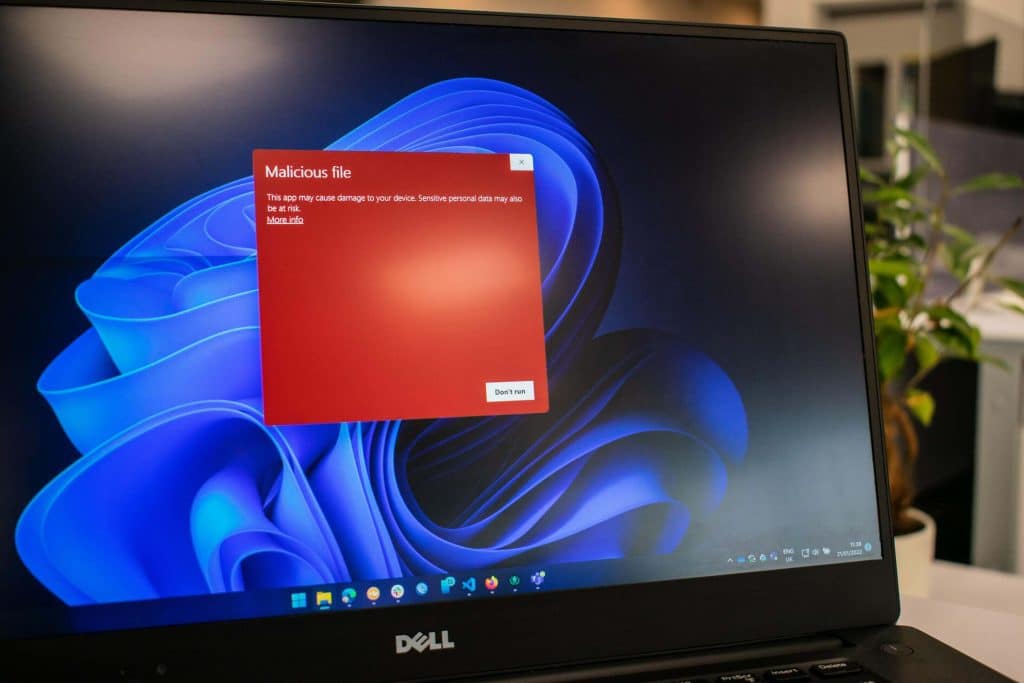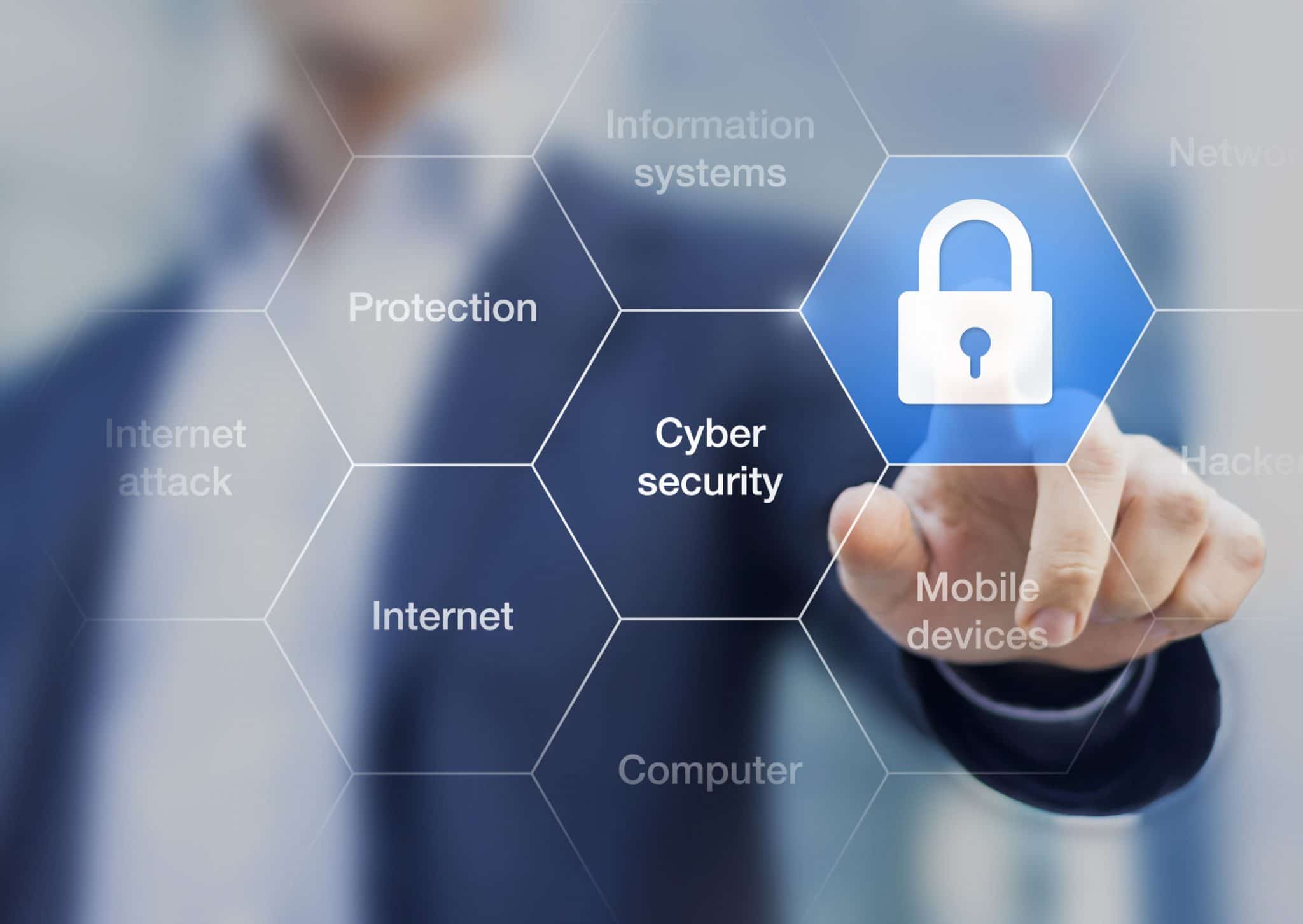On the Internet, information is widespread—and business operators, alike, risk data theft. Every year, technology becomes more complicated—and so do cyber attacks. The world of digital crime is expansive—and it isn’t exclusive to any particular Internet-accessible platform. Desktops, smartphones, and tablets may each carry a degree of digital defense—but each has inherent ‘weak points’ to which hackers have become attuned.
Fortunately, some digital security tools and services run parallel to their ill-intended tech counterparts. Even though our digital landscape’s complexity obscures advanced threats, most can leverage network-based assaults with digital disaster prevention tools.

Before we dive into these common threats, let’s dive into the cornerstones of digital security. Because today’s digital threats don’t exclusively exist on hardware, so ascertaining risk requires a different approach—one which prioritizes controlled network security over all else.
Defining Modern Cybersecurity: Network-Based Safety
When the term ‘cybersecurity’ comes to mind—we tend to assume it encompasses all facets of modern technology. This is understandable, as it’s technically accurate. Digital safety tools have become incredibly flexible—having been adopted by numerous industries of numerous designs.
The driving factor behind this technicality, then, is a little easier to understand:
Most devices—including navigation apps, game apps, and social media, are always connected to the Internet. Likewise, so are desktops. Whether you’re perusing a store or listening to music—chances are, you’re engaging in this encompassing environment that necessitates cybersecurity’s modern definitions.
Cybersecurity jobs, today, handle the digital defense of information sent and received between digital devices; in essence, network defense. It involves information storage protection, the identification of intrusions, the response to cyber attacks, and—in worst-case scenarios—the recovery of valuable, often personal, information that’s been stolen. Understandably, cybersecurity’s scope is pretty big—and the salary for cybersecurity professionals is sizable, too. Cybersecurity’s niche’ approach to digital safety immediately raises a question, however:
What encompasses cybersecurity itself?
Network Security
Whereas cybersecurity primarily focuses on data transfer and storage, network security is a bit broader. As per its name, network security involves the defense, maintenance, and recovery of networks in general. It encompasses cybersecurity as a defensive umbrella of sorts, protecting all network users from all digital threats—even if a given cyber attacker has intentions other than data exploitation.
To protect the integrity, safety, and sustainability of a network’s users, network security professionals tend to focus on connection privacy. This preference is synonymous with the practice of cybersecurity, resulting in the two terms often used interchangeably.
This said, the vehicles of network security services also encompass anti-virus software, malware detection tools, firewall upgrades, virtual private networks (VPNs), and other security programs. So, even though network security and cybersecurity pros often cover similar bases, they deviate at intersections wherein things like data storage and data tracking need overlap.
Of course, these intersections also tend to be serviced by additional security providers—each arriving from their own, specialized avenues of digital risk management. While these additional cyber crime defenders conduct vital services, however, they’re not as far-reaching as network security is—or even cybersecurity, for that matter.

Because of this, professionals of cyber threat reduction can be considered in an umbrella ‘hierarchy,’ of sorts: Network security, in most cases, extends in some way, shape or form, to each of these spheres—existing as the ‘top’ umbrella. Subsequently, cybersecurity defines a userbase’s primary concern with data protection. It ‘covers,’ or concerns, three other spheres of cybersecurity framework management: information security, operational security, and application security.
Information Security
Most, if not all, commercial workplaces utilize networks to synchronize every facet of day-to-day operations. They handle user logins, schedule management tools, project software, telecommunications, and more—necessitating the employment of those capable of holding it all together:
An information technology security team.
Their continuous monitoring keeps a network’s traveling information secure, assuring only authorized users can access its services. It’s important to note their difference from cybersecurity professionals, however, as their goals can easily be confused. Cybersecurity pertains to the protection of valuable data—such as social security numbers, business transaction logs, and stored infrastructure data. Information security, meanwhile, protects digital traffic.
Even though valuable data can indeed be parsed from this traffic—resulting in yet another service overlap—information security professionals are the direct responders. This area of work covers disaster recovery planning: processes enacted via rigorous risk assessments, practiced response strategies, and concrete plans for long-term defense.
Operational Security
Also referred to as OPSEC, operational security is commonly held in high regard for its modular design as a risk management process. It encourages company management teams to view their commercial operations from an external point of view—to identify potential lapses in overall security. While companies often succeed in managing public relations, risk-free, data thieves may still glean sub-textual information throughout. In this scenario, the risk of data theft becomes much higher—as parsed data compiled into actionable information, externally, eludes the standard security protocols behind a business’s walls.

OPSEC can be categorized into five distinct steps:
One: Identify Potentially Exposed Data
Operations security takes great care in exploring every scenario in which a cyber attacker might extract meaningful data. Typically, this step includes the analysis of product searches, financial statements, intellectual property, and public employee information.
Two: Identify Potential Threats
For every identified data source deemed sensitive, operational security teams take a closer look at potential threats. While third-party providers are commonly analyzed first due to their proximity, insider threats are also considered. Negligent or otherwise disgruntled employees may indeed pose a threat to a business’s data integrity—whether intentionally or accidentally.
Three: Analyze Risk Severity
Because data value varies widely, it’s in a business’s best interest to identify the degree of damage potential exploits might cause. By ranking vulnerabilities based upon attack likelihood chances, a team can even determine the likelihood of different cyber attacks.
Four: Locate Security Weaknesses
Operational management teams are also highly capable of information security operators. By assessing current safeguards and identifying any system loopholes, they can spot weaknesses well before being exploited. This information can also be compared with insights ascertained from the previous three steps—to get clearer outlooks on a threat-to-threat basis.
Five: Plan Countermeasures
Once more, preventative methods are of top concern for those who practice digital security. This last OPSEC step serves to mitigate risks before risk elimination is an unavoidable approach. Step Five typically involves updating hardware, initiating new digital policies for data protection, and training employees in the latest security measures.
Application Security
Even though commercial networks operate on custom-tailored software platforms, application-specific threats still exist. Application security is the initiation of protective measures on the application level. This includes both software and hardware security to minimize exploitation threats, which often spawn from outdated firmware and aged platforms.
Application security teams prevent app code from being hijacked, implementing several firewall-centric security measures alongside software modifications and encryption. Because many of today’s applications are cloud-based, network access persists as a potential threat. Fortunately, many application security workers are experts at eliminating vulnerabilities on the app-to-network level.
By and large, security on the app level benefits every sphere of a company’s digital defense framework. Most app security implementations revolve around software authentication, intensive logging, and constant authorization inspections in unison—to be ever-reliable. Cybersecurity management varies on a network-to-network basis. Still, virtual runtimes are a stable cornerstone upon which reliable, adequate security measures can grow—especially when backed by general data protection regulation updates.

Advanced Persistent Cybersecurity Threats
Over the years, renowned entities like the National Institute of Standards and Technology or NIST have greatly enhanced economic security across industries. Meanwhile, the three primary elements of information security—the ICA or Integrity, Confidentiality, and Availability triad—keep the public informed about the world’s most recent, highly dangerous digital attacks.
Despite the public’s general awareness of spyware and adware, the potential threat posed by malicious scripts, bots, and malicious UI modifications tends to be overlooked. In recent years, phishing and ransomware have proven a rare prevalence inherent in digital elusivity. Occasionally spotted, their accurate identification similarly verifies tricks of the trade having inherited our tools—freshly sharpened for digital exception exploitation against the grind of today’s strongest firewalls.
So it seems, cyber criminals have adopted, and have capably learned, the ins and outs of today’s leading information systems: innovations otherwise mastered by their respective creators and management teams.
The targets remain clearly defined, and no deviation from them has yet to be seen. Entities with extensive data collections—commercial properties—are ever a bullseye. But now, it seems, a common purpose of eroding digital defenses may very well have devastating impacts. Commercial data stockpiles aren’t highly appraised by thieves for their operational DNA—but for their customers’ digital footprints.
Identifying a Cyber Attack
Understanding a malicious digital object’s mode of operation dramatically increases one’s security—both online and offline. These nefarious tools do pose extensive threats, undoubtedly, but their digital footprint patterns have given us valuable knowledge to avoid them, or even eliminate them if they’re encountered. One should never stop being cautious, however, as they’re elusive by design.
Behind the Term: Hacking
We hear the word ‘hack’ quite a lot. One might assume, reasonably, that hacking is an action taken to sidestep usual barriers to entry—whatever they may be. This is correct. When it comes to digital environments, hacking is a broad-stroke term used to describe the practice of compromising digital devices. Not all hacking is malicious, as system developers frequently employ hacks to test system security. Still, a majority of hacks are conducted as illicit activities.
Hacking defines direct attempts to breach platform security protocols via implemented scripts. It also, however, can be passive—such as the creation, and careful placement, of dangerous malware. Let’s take a closer look at today’s most common digital attacks through this lens—wherein each malicious activity below, regardless of their respective tools, falls into the hacking category.
Malware
Malware is often referred to, yet its intricacies tend to surprise people. Most simply consider malware to be a benign, albeit, more inconvenient version of adware. While the two are similar, malware can be far more dangerous if it isn’t identified, quarantined, and removed.
Malware’s namesake, ‘malicious software,’ is a blanket term that encompasses various viruses and trojans. The tools implement digit-based code attacks to disarm or bypass a system’s security architecture. Malware’s pre-scripted destinations, of course, are directories known for storing vital operating system components.

Malware is identified by the way it spreads: Viruses and trojans, while both ‘malware,’ engage a target system in different ways. A virus contains a small string of computer code—one which is placed within a file typically presented as a benign download. The code is designed to self-replicate across an operating system, ‘hopping’ from program host to program host. Upon finding a program flexible enough for control, the virus takes control—forcing it to perform malicious actions against the system’s users. Sometimes, this manifests as simple inconveniences—such as programs that continuously launch, toggle themselves as startup processes, or can’t be removed from background processes.
Sometimes, however, the malware’s host is a target linked to external financial accounts, valuable file information, or registry keys.
Trojans are popular tools of cyber attacks, too. Often hidden within downloadable programs, trojans technically can’t self-replicate—initially, at least. Instead, they must be launched by a user first. Once launched, however, trojans can spread throughout a system far quicker than viruses—sweeping many locations for information, system tools, and connections to valuable, external accounts.
Phishing
Much like malware, phishing involves deceiving users into approaching an online service. However, unique to phishing is its focus not on breaking into a user’s system but tracking them for valuable information. Phishers typically come into contact with users via email – as the process spawns from direct deceit. Phishers pretend they’re people they’re not—specifically those who, hypothetically, would serve as a notable authority figure.
Phishers commonly masquerade as banking institution officials, insurance agents, and account service people. Via fraudulent contact information and email design mimicry, a phisher ultimately wants the recipient to click a link of some sort. Typically, the cyber attacker urges them to access the link as a way to reach one of their accounts or get in touch with another representative.
As one might guess, these malicious links can launch code strings when clicked—immediately jeopardizing the victim’s digital security. Most phishers have malware as their link-based weapon of choice. This said, advanced phishers have been known to launch far more complex, exceedingly dangerous scripts.
Ransomware
Also, in the realm of direct-communication cyber attacks is the use of ransomware. Ransomware, as per its name, is malware hinged upon a monetary demand—or a ransom. While some cyber attacks are motivated, driven, and executed to steal data for sale, ransomware usage is far more direct.
Ransomware is grounded in the use of encryption software. Usually smuggled into the victim’s computer similarly as phishing scripts, this type of malware serves to ‘lockdown’ the victim’s digital assets—rather than pursue them for theft. While this information can indeed be vital information such as one’s financial account details, it tends to be usable for blackmail.
Specifically, ransomware cybercriminals target corporate secrets, product designs, or any information which might damage the business’s reputation. The ransom is announced soon after—wherein the attacker demands direct funds for the safe return of the victim’s inaccessible, and stolen information assets.
Social Engineering
Sometimes, digital applications aren’t needed to exploit valuable information. Social engineering has become quite popular among the online world’s exploitative use—rendering even some of the most secure user-based platforms defenseless. It requires no tools as a means of online communication—as it revolves around psychological tricks, and very little more.
Social engineering attacks occur when a perpetrator begins investigating their intended victim for background information and information about the individual’s current digital security habits. After doing this, the attacker initializes contact—often through email. With the information parsed earlier, the attacker can effectively pretend to be a trusted and sometimes even authoritative figure.
Most social engineering attacks pursue valuable information via spoken word. Even the mere verbalization about a potential digital security weak point-can lead the attacker to the information they need—accessibility credentials for valuable accounts.

Other Threats to Unsecured Platforms
The above-mentioned digital assaults don’t stand alone as the most dangerous cyber weapons an Internet attacker can wield—but they tend to be the most common. While high-capacity hacks, decryption tools, and complicated scripts capable of breaching high-security networks do exist, they tend to be rarer—as their usage requires both a high degree of digital knowledge and criminal know-how to avoid detection.
Cross-Site Scripting
Other ‘tricks of the hacker’s trade’ tend to revolve around cross-site scripting—wherein digital code is inserted into vulnerable user interfaces and web applications: JavaScript, CSS, and ActiveX being the most popular targets. This is called ‘CSS injection.’ It can be used to read HTML sources containing a sensitive date. Understandably, active XSS attacks can be used to track a user’s online activities—and even introduce entirely separate, malicious websites into the mix.
DNS Spoofing
The act of introducing fraudulent, and often dangerous, websites into safe environments is called DNS spoofing. It’s done by replacing a DNS server’s IP addresses with one’s own—thereby disguising it beneath a URL users are likely to click. The disguised website destination is often designed to resemble its real-world counterpart.
Soon after arriving, users are prompted to log into their accounts. If they do, their login credentials are saved and stored by the attacker: tools for eminent digital exploitation, soon.
The Best Practices in Cybersecurity
Our new digital defense inventories are packed with powerful security tools. Even simple mobile device security in the form of two-factor identification dramatically reduces the odds of successful attacks. Jobs with cybersecurity tools must always be informed of emergent hacking trends.
As for the other tools—those concerned for their online security have a few to choose from. More important than tools themselves, however, are the methods behind their employment.

Identity Management
Also called ‘ID Management,’ identity management involves the use of authorization. This practice ensures that the right people have access to the right parts of a system—and at precisely the right time. Because digital user rights and identification tests are contingent upon user specificity, they sometimes share a double purpose as data protection tools.
Mobile and Endpoint Security
Smartphone apps, mobile web services, and firmware have some extent of digital security—but smart devices still tend to be the first recipients of cutting-edge software security options. This isn’t necessarily because they’re unsecured—but because of their positioning within a given network.
Namely, system endpoints.
Whereas desktops can be USB hubs, mobile devices are merely self-sustaining by design. Because of this, they’re mostly digital doorways to entire network architectures. To keep these doorways shut—both for the device’s safety and network’s virtual integrity—tech teams often use monitoring and management toolkits.
They can conduct manual device patches, real-time monitoring services, automation scripting, and fundamentally transform simple mobile devices into full-fledged, handheld security suites.
End-User and Cloud Security
At times, security providers and a business’s end-users use the same tools to protect themselves. One of these tools is cloud-based security. Organizations can extend corporate security controls capable of rapidly detecting, responding to, and removing cyberterror objects.
Cloud security environments might be seamless in terms of accessibility—but their high-end encryption standards make them nearly impenetrable. Their mix of features is form-fitting to most jobs for cybersecurity, keeping workers secure regardless of their location.
Learning More About Network Security
To stay safe in the online world, a user must keep their industry knowledge up to date. You don’t necessarily need a cybersecurity degree, however. Information is widely available online—and plenty of cybersecurity experts offer cybersecurity certifications beyond the classroom.
Despite the Internet having risks, plenty of online users never encounter malicious hackers at all. Fortunately, today’s digital security tech—both hardware and software—is similarly advanced. Between platform-included security suites, encryption, firewalls VPNs, and the anti-tracking add-ons of today’s Internet browsers, being passively safe is undoubtedly possible.
It’s best not to take any chances, in any event, as perceivably minor digital threats can evolve—becoming full-fledged, multi-device, data-breaching digital weapons. Regardless of your daily Internet usage, career computing resources, or mobile device apps—preventative care is your biggest asset.
To nurture this asset, pursue new knowledge whenever you can—professionally or otherwise. You can take the first step with our Cybersecurity Professional Bootcamp. Gain hands-on experience with simulation training led by active industry experts and get one-on-one professional career coaching. In less than one year, you can become a well-rounded professional ready for your first day on the job.
Fill out the form below to schedule your first call or reach out to our admissions team at (734)-707-9985 to get started today!


